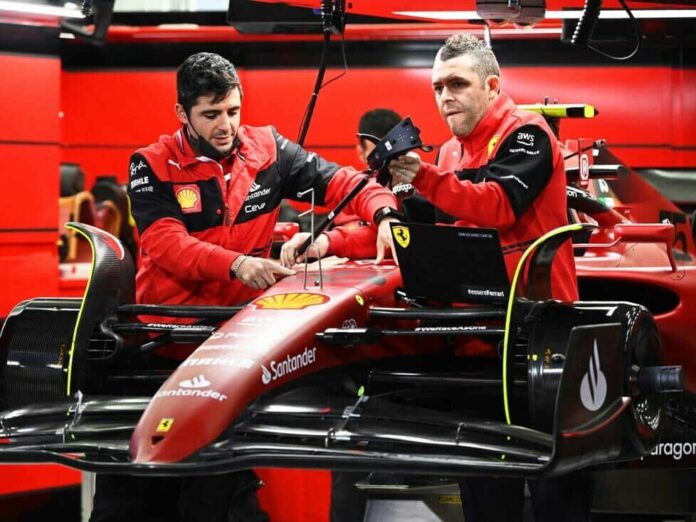Formula 1 expert Marc Surer explains why it took Ferrari two years to get the engine running again – just in time for the “engine freeze “
Ferrari celebrated a double victory at the season opener in Bahrain, but the upturn in form is not limited to the factory team alone. The customer teams Haas and Alfa Romeo are also experiencing a revival in Formula 1 2022. Coincidence? The insiders in the paddock agree: it’s also due to the reinvigorated engine.
“The Ferrari engines are definitely back to where they were in 2019,” says AlphaTauri driver Pierre Gasly, and Valtteri Bottas, who has just made a switch from Mercedes to Ferrari power, reports first-hand: “I think there is almost no difference between the engines anymore. It’s important that we have that power.”
Team boss Mattia Binotto spoke before the start of the season of a 25bhp deficit that Ferrari had made up with the new power unit. They were “certainly not behind anymore, and maybe we even have a tad more power,” was his assessment – even before last weekend’s one-two in Bahrain.
However, it was not the pure top speeds with which Ferrari could shine. In qualifying, pole setter Charles Leclerc was “flashed” at 316.6, Carlos Sainz at 315.9 km/h. That was around seven km/h less than the Red Bulls, who will also be competing with Honda power in 2022, albeit under the Red Bull Powertrains label.
The duel between Max Verstappen and Leclerc, with six lead changes between lap 17 and lap 19, proves that Red Bull and Ferrari must have been running with different wing settings. Ferrari, thanks to their new found horsepower, can afford to go for more downforce and accept more drag in return.
Red Bull puzzled by Ferrari’s consistency in power
Red Bull motorsport consultant Helmut Marko is surprised in an interview with ‘Sky’ that “they can go a race distance with it” without having to throttle the engine. The good news: “We are not far away from Ferrari.” The Honda engine can’t be that bad, otherwise Verstappen wouldn’t have sucked up to Leclerc so rapidly at the end of the start-finish straight.
Flashback to 28 February 2020: Shortly before the end of the last day of testing in Barcelona, an FIA press release flutters into the mailbox of the motorsport press: “FIA concludes Analysis of Scuderia Ferrari Formula 1 Power Unit”. One of the first analyses read: “This is probably the biggest bombshell to rock Formula 1 since ‘Crashgate’ more than a decade ago. “
Evidently Ferrari had been cheating in the engine department until 2019, exploiting grey areas, at least not developing in line with the regulations. The FIA, then led by former Ferrari team boss Jean Todt, and the Scuderia from Maranello agreed on a deal, a kind of settlement. The details of this agreement are kept secret to this day.
Ferrari had to rebuild the engine – and then, just like the Ferrari customer teams, plunged into sporting nirvana. They finished the 2020 season in sixth place with 131 points, and the 2021 season in third place in the Constructors’ World Championship with 323.5 points. A powertrain update introduced in Sochi 2021 significantly reduced the technical deficit.
For 2022, Ferrari is said to have succeeded in tickling even more power out of the power unit – and this despite the fact that Formula 1 has switched from E5 to E10 petrol by regulation, with twice the bioethanol content. That should actually cost horsepower. Convenient for Ferrari: large parts of the drivetrain have been homologated since 1 March, so development is frozen until the end of 2025.
Technical updates to the combustion engine, the turbocharger, the MGU-H, the exhaust and the specification of petrol and oil are now no longer possible. Only the MGU-K, the control electronics and the battery may still be fine-tuned until 1 September 2022. Then the FIA homologation will also apply to these components.
“But they have caught up. I think it’s just noticeable now because they’ve had good results in the past with an inferior engine. Now they’re practically back on the same level as Mercedes and Honda. I wouldn’t say anyone is really better. “
Ferrari resurgence: how does it relate to 2019/20?
Surer sees a connection with what happened in 2019/20. Ferrari at that time, he says, injected more fuel than allowed, at least at phases, “and when you inject more fuel, you have an engine that works well when it has enough fuel. That means you build the engine, the combustion chamber, you build everything designed for enough fuel.”
“All the others who had to cope with less fuel built so-called lean-burn engines,” Surer surmises. But then came 28 February 2020, “and suddenly they were no longer allowed to use this trick”. Ferrari also had to switch to a “lean engine”, “and they didn’t have any experience then”.
Now Ferrari had two years to make up for this deficit, and it seems to have succeeded in painstaking development work. Surer leaves it open whether Ferrari really cheated back then: “Otherwise they would have been disqualified. But they definitely cheated. Injecting more petrol”, is his analysis.
That’s why Ferrari was “bad” in 2020 and “already better” in 2021 as far as the engine was concerned. “Then they also improved the hybrid last year. There we saw a big progress in acceleration. And now they have also managed to get the combustion right, so that they can get the optimum performance out of the new biofuel with a lean-burn engine.”
The fact that Ferrari needed two years to recover from the forced technical changeover was “a normal process in development”. On the other hand, he considers conspiracy theories that the secret FIA-Ferrari deal could involve Ferrari not being allowed to race at full power again until 2022 to be nonsense.
“They just had the shock: ‘Oh, we can’t run on that much fuel anymore. Now we have to build a new engine.’ And they had no experience then,” the former Formula 1 driver believes. Convenient that Ferrari managed the turnaround just in time before the so-called “engine freeze” …







